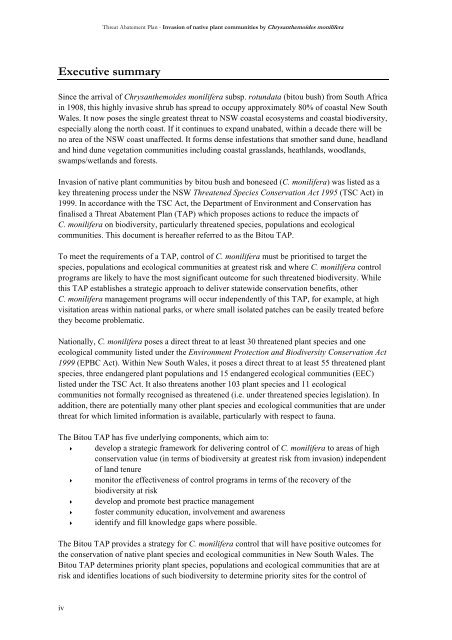NSW Bitou Bush Threat Abatement Plan - Department of ...
NSW Bitou Bush Threat Abatement Plan - Department of ...
NSW Bitou Bush Threat Abatement Plan - Department of ...
Create successful ePaper yourself
Turn your PDF publications into a flip-book with our unique Google optimized e-Paper software.
iv<br />
<strong>Threat</strong> <strong>Abatement</strong> <strong>Plan</strong> - Invasion <strong>of</strong> native plant communities by Chrysanthemoides monilifera<br />
Executive summary<br />
Since the arrival <strong>of</strong> Chrysanthemoides monilifera subsp. rotundata (bitou bush) from South Africa<br />
in 1908, this highly invasive shrub has spread to occupy approximately 80% <strong>of</strong> coastal New South<br />
Wales. It now poses the single greatest threat to <strong>NSW</strong> coastal ecosystems and coastal biodiversity,<br />
especially along the north coast. If it continues to expand unabated, within a decade there will be<br />
no area <strong>of</strong> the <strong>NSW</strong> coast unaffected. It forms dense infestations that smother sand dune, headland<br />
and hind dune vegetation communities including coastal grasslands, heathlands, woodlands,<br />
swamps/wetlands and forests.<br />
Invasion <strong>of</strong> native plant communities by bitou bush and boneseed (C. monilifera) was listed as a<br />
key threatening process under the <strong>NSW</strong> <strong>Threat</strong>ened Species Conservation Act 1995 (TSC Act) in<br />
1999. In accordance with the TSC Act, the <strong>Department</strong> <strong>of</strong> Environment and Conservation has<br />
finalised a <strong>Threat</strong> <strong>Abatement</strong> <strong>Plan</strong> (TAP) which proposes actions to reduce the impacts <strong>of</strong><br />
C. monilifera on biodiversity, particularly threatened species, populations and ecological<br />
communities. This document is hereafter referred to as the <strong>Bitou</strong> TAP.<br />
To meet the requirements <strong>of</strong> a TAP, control <strong>of</strong> C. monilifera must be prioritised to target the<br />
species, populations and ecological communities at greatest risk and where C. monilifera control<br />
programs are likely to have the most significant outcome for such threatened biodiversity. While<br />
this TAP establishes a strategic approach to deliver statewide conservation benefits, other<br />
C. monilifera management programs will occur independently <strong>of</strong> this TAP, for example, at high<br />
visitation areas within national parks, or where small isolated patches can be easily treated before<br />
they become problematic.<br />
Nationally, C. monilifera poses a direct threat to at least 30 threatened plant species and one<br />
ecological community listed under the Environment Protection and Biodiversity Conservation Act<br />
1999 (EPBC Act). Within New South Wales, it poses a direct threat to at least 55 threatened plant<br />
species, three endangered plant populations and 15 endangered ecological communities (EEC)<br />
listed under the TSC Act. It also threatens another 103 plant species and 11 ecological<br />
communities not formally recognised as threatened (i.e. under threatened species legislation). In<br />
addition, there are potentially many other plant species and ecological communities that are under<br />
threat for which limited information is available, particularly with respect to fauna.<br />
The <strong>Bitou</strong> TAP has five underlying components, which aim to:<br />
< develop a strategic framework for delivering control <strong>of</strong> C. monilifera to areas <strong>of</strong> high<br />
conservation value (in terms <strong>of</strong> biodiversity at greatest risk from invasion) independent<br />
<strong>of</strong> land tenure<br />
< monitor the effectiveness <strong>of</strong> control programs in terms <strong>of</strong> the recovery <strong>of</strong> the<br />
biodiversity at risk<br />
< develop and promote best practice management<br />
< foster community education, involvement and awareness<br />
< identify and fill knowledge gaps where possible.<br />
The <strong>Bitou</strong> TAP provides a strategy for C. monilifera control that will have positive outcomes for<br />
the conservation <strong>of</strong> native plant species and ecological communities in New South Wales. The<br />
<strong>Bitou</strong> TAP determines priority plant species, populations and ecological communities that are at<br />
risk and identifies locations <strong>of</strong> such biodiversity to determine priority sites for the control <strong>of</strong>
















